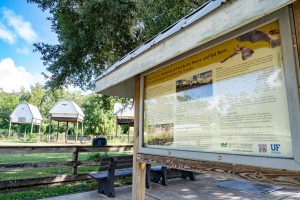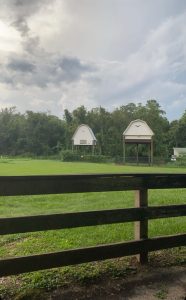
University of Florida football games are a lot of fun to watch in person. Being in The Swamp, yelling for the team, singing “I Won’t Back Down” with 88,500 other fans acapella; these are experiences every Floridian should have. But every on the other side of campus is a daily athletic spectacle that, to a wildlife nerd like me, is just as exciting.

In the early 90’s, a huge colony of bats expressed their school spirit by moving into a track and field stadium. As you can imagine, having thousands of bats flying around as athletes took the field was a little distracting. So the wildlife ecology and facilities folks put their heads together and came up with a plan to relocate them safely. A huge bat house was built in a field across from Lake Alice, then the bats were excluded—blocked entry—from their previous roost. In a perfect world, the bats would’ve happily moved right into their new condominium. In reality, they left campus and didn’t reform a big colony for three years!

This time, they decided to fill in the new space permanently. The fully occupied bat barns house 250,000 bats each! When capacity maxed out in the first building, two additional bat houses of equal size were constructed. Eventually, the insides of the oldest house rotted out from years of used and bat guano buildup. It was rebuilt, but before Hurricane Ian passed through in 2022, the oldest house was removed and the bats relocated to the other two houses. Plans are in the works to rebuild a third house. At present, biologists estimate that 450,000-500,000 bats live in these manmade habitats. The residents are Brazilian free-tailed bats, a species known for creating large colonies. Nightly, the bat house residents collectively eat 2.5 billion insects per night.
Gathering along the fence outside the bat houses is a nightly tradition for students and campus visitors. Each night, 10-15 minutes after sunset, the bats start making their way out of the house. From a trickle it becomes a flood, with an aerial river of hundreds of thousands of bats streaming out for their nightly feeding. From start to finish, it takes a solid 15-20 minutes for all the bats to exit. Just before and while the bats are flying, a couple of enterprising hawks stake out spots on branches near the houses, hoping to snag a bat for dinner themselves.
All in all, it’s a fascinating—and free—experience that I highly recommend to anyone passing through Gainesville. Summer is the best time to watch!
 7
7
